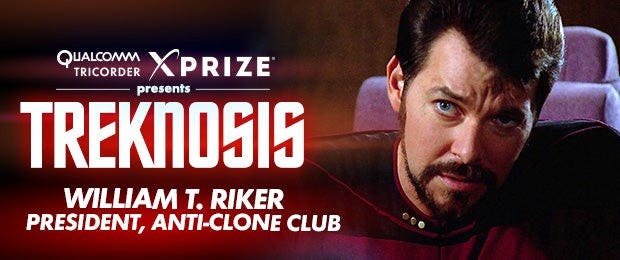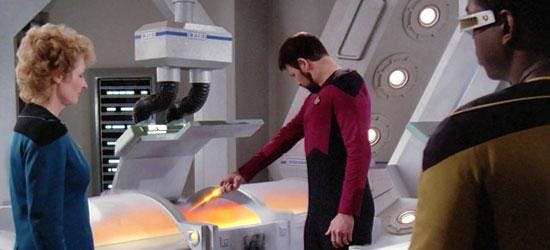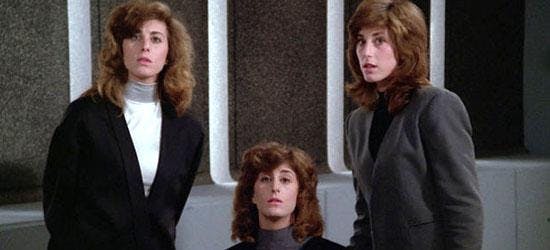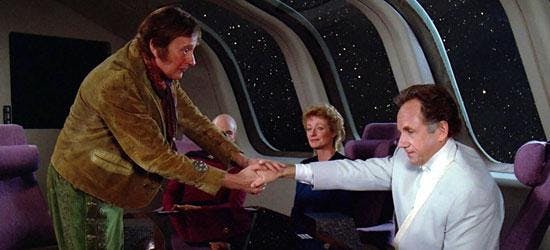Published Jul 28, 2014
TREKNOSIS: William T. Riker: President, Anti Clone Club
TREKNOSIS: William T. Riker: President, Anti Clone Club

Stardate 42823.2: Sent on a mission to investigate the cause of an antique distress signal from a remote corner of the Alpha Quadrant, the USS Enterprise (NCC 1701-D) discovers two long-lost Terran colonies, in this Star Trek: The Next Generation episode, “Up the Long Ladder.” One of them, Bringloid V, is a jolly conclave of bumbling Irish stereotypes; the other, Mariposa, has a diversity problem of an entirely different kind: they're all clones. More precisely, they're all clones of the only five people to survive the crash-landing of the original colony ship, and now they're up against a wall. Like a photocopy of a photocopy of a photocopy, Mariposan DNA has begun to suffer from a condition they call "replicative fading," and soon they won't be able to make any more clones of themselves. How do they think the Enterprise can help? By donating their DNA so the Mariposans can make clones of them instead. For some reason, nobody else thinks this is a great idea.
As self-appointed co-founder and president of the Anti Clone Club, William T. Riker puts it, “No way, not me.” When the Mariposan assures him that he wouldn’t be harmed, Riker responds, “It’s not a question of harm. One William Riker is unique, perhaps even special. But a hundred of him, a thousand of him diminishes me in ways I can’t even imagine.”

But is he right? I'm not entirely sure.
First of all, does a clone actually count as a copy of you? I’ll grant that a clone of me would have my exact DNA, so we'd undoubtedly look alike -- or at least he'd look like a version of me from 34 years ago. So, a baby. In time, as he'd grow and mature the way we humans tend to do, he'd resemble me throughout (sorry about the awkward teenage acne, bro) until reaching the age I am now, at which point he'd be physically indistinguishable from any selfie of mine taken this year. Of course, by then I -- the original Jon -- would be 68 years old and cultivating a Pai Mei-length Fu Manchu beardstache if all goes to plan.
You get the point, of course: no clone of me made with current technology could ever hope to be an exact copy of me as I am now. The Mariposans had cloning machines capable of making fully-grown individuals, but I'm still not convinced they'd be exact copies. Sure, a Mariposan clone of me would look exactly like me, but he'd still be missing a huge part of the recipe that created me: my memories and experiences.

Nature vs. nurture is a question nobody's really been able to answer. How much of your personality, yourself, is determined by your genes and how much of it is defined by the things you experience? It's not something anybody's going to be able to test anytime soon, either; what would that even look like? You'd need to find a set of baby quadruplets, divide them into pairs, and raise each pair in strict laboratory conditions -- both members of one pair receiving the same treatment from the exact same parents, the other pair getting radically different parenting. Then, after about twenty years, you'd need to give all four of them the same battery of psychological tests to see what differences emerged. Presumably you'd be doing this from prison, because every human rights commission on Earth would unite as one to throw you in jail forever.
I'm going to take the position that the things you've seen and done make up some nonzero percentage of your personality, which means even if you could make a clone who was the same age as me instantly, he still wouldn't really be an identical copy. So would I feel diminished in the same way Commander Riker talks about? I don't think so. Riker's speech sounds to me like the complaints I hear whenever a sub-par movie based on a book comes out. So what if Watchmen wasn't great? The book is still on my shelf at home, and I can read it whenever I want. So long as my clone doesn't run around claiming to be me, we're all good! (Duplicates of me created in a transporter accident are a whole different matter – lookin' at you, Thomas Riker.)

What does sound more legit to me is the Mariposan problem of replicative fading. Let's be clear up front, though: the structure itself of DNA makes it perfectly designed to be copied over and over again while eliminating errors. Trying to calculate how many times a DNA strand needs to be copied depends on things like the kind of cell it's in, the organism it's part of, and how old it is, but think about how many cells are in your body (about 37 trillion by some estimates) and you start to get some idea of how impressive that is. But if there's any universal constant, it's entropy: the DNA replication process sometimes makes blunders, and mutations after the fact are always possible. At some point, the cold hard math says you'll eventually end up with something that's more mistakes than original DNA. But don't worry. At that point, you'll have long ceased to grow anything even vaguely biologically viable! The Mariposans were probably just starting to stare down the slope of that exact decline when the Enterprise showed up. Fortunately, between the crew's reluctance to be cloned and the affability of the Mariposans' long-lost fellow Bringloidi colonists, everyone was able to arrive at a mutually beneficial solution, but personally, I would've been first in line to donate some epithelial cells.
Jon Sung is a contributing writer for XPRIZE and copywriting gun-for-hire to startups and ventures all over the San Francisco Bay area. When not wrangling words for business or pleasure, he serves as the first officer of the USS Loma Prieta, the hardest-partying Star Trek fan club in San Francisco.
XPRIZE is an innovation engine. We design and operate prize competitions to address global crises and market failures, and incentivize teams around the world to solve them. Currently, we are operating numerous prizes, including the $30M Google Lunar XPRIZE, challenging privately funded teams to successfully land a robot on the Moon’s surface, and the $10M Qualcomm Tricorder XPRIZE, challenging teams around the world to create a portable, wireless, Star Trek-inspired medical device that allows you to monitor your health and medical conditions anywhere, anytime. The result? Radical innovation that will help us all live long and prosper.
Sign up today to join our mission, be a part of our campaign and win collectibles at: tricorderfederation.org.





